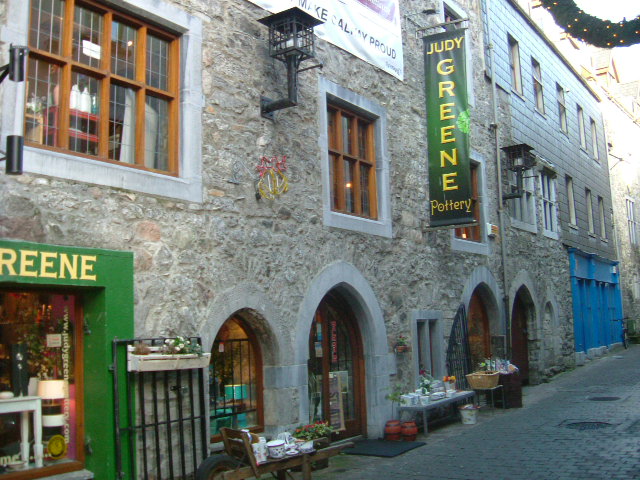
Galway, Ireland
Category: The Great Town Award 2013
Assessor: Nick Wright / John Lord
Date of Visit: 2012
Learning Moments
One of the fastest growing towns in Europe since the 1960s, Galway offers an opportunity to create a new paradigm for urban development based on a walkable town centre spreading out to surrounding inner urban areas and suburban development which is both attractive but also sustainable. Galwegians would be the first to admit that the results are not perfect, but there are some valuable lessons for other places in Ireland and the UK – building tenure-blind suburbs, revitalising moribund historic commercial property and retrofitting out-of-town commercial centres, to name but three.
2. Economic diversity
Galway has weathered the economic crisis since 2008 with relative success. There are many reasons for this, but one is the diverse local economy: high performing universities, a strong IT sector, international tourism, a big focus on Irish culture, and of course the town’s role as a regional centre. Year-long event programming also seems to make a major contribution. The town taps into a range of economic drivers and markets, and reduces the unwelcome seasonality that would be associated with a greater focus on just higher education or tourism.
The Galway visitor experience is focused on the medieval core which is often packed, sometimes uncomfortably so compared to post-enlightenment Northern European townscapes. But the city has other pleasures and delights which deserve to be better known. Some of the town’s most memorable environments are related to water – the dramatic River Corrib and its tributaries, a network of mill streams, the canal, seafront promenades and tidal flats.
4. People and partnership
There appears to be a genuine enthusiasm for working together and a pride in how well partnerships work. Rather than seeing securing a partnership as an achievement, working in partnership is seen as part of being a good Galwegian. Partnership is a pleasure rather than a task. That attitude that seems to translate into projects that put people at their heart, and a human scale of development which works well.
Assessment Summary
Galway is a town on the edge; a gateway to the Atlantic and new horizons. It is also a hugely interesting place with a remarkable history. Although proudly and justifiably proclaiming its city status, in terms of size and character, Galway is undoubtedly a candidate for Great Town status. The town centre’s perfectly preserved mediaeval street pattern is unique in Ireland, and is today thriving and bustling, full of life, commerce, history and culture. There are valuable lessons here in repopulating the town centre and recycling old buildings, waterways and spaces through investment, incentives and policy.
Equally interesting for contemporary urbanists is the story of the town’s growth over the last fifty years: Galway has more than tripled its population to 75,000 and expanded its urban area ten-fold. How the town has handled the tensions and opportunities associated with this breakneck growth is very interesting.
The town’s growth has led to rapid suburbanisation since the 1960s. Inevitably, these generally car-orientated residential and commercial developments lack the charm and character of the town’s historic core. But the results are not all bad. For example, more recent residential neighbourhoods are pleasant, compact and tenure-blind places to live. There is good work in progress to stitch recent commercial developments into their surrounding neighbourhoods. Challenges remain for the existing suburbs and future growth, for example, how to break that car dependency that has emerged over the last 50 years? And how to create contemporary neighbourhoods of a quality that matches the town centre?
Culture and acceptance are at the heart of Galway. Founded by the Normans and part of the mediaeval maritime superhighway of trade that linked Western Europe’s ports, the town has always been shaped by incomers. There is something of the feel of the historic merchant areas of Amsterdam or Lisbon about the place. Today, Galway attracts around 2 million visitors a year, attracted not least by culture – Irish music in the streets and bars, Galway’s position as the gateway to Connemara’s Gaeltacht, and a busy programme of events and…Cont. …festivals throughout the year – in particular, high profile arts and food festivals. Many choose to stay and make Galway their home, continuing the town’s long tradition of welcoming incomers. This gives the city an international buzz that is unexpected in this location and size of town.
The assessment team came away from Galway with a real sense that our hosts from the public, private and community sectors really do enjoy and take a pride in working together – and achieve much more as a result. There is a pride in being Galwegian; there is also an openness to new ideas and people.
Today’s Galway has a sense of purpose and economic vitality over and above its popularity as a tourist destination, due in no small part to the significant higher education presence and the town’s success at capturing and rooting successive waves of foreign direct investment since the 1960s. Galway appears to be punching above its weight in terms of it being an attractive, vital place – particularly given the strength of the recession in Ireland. But the town’s place quality needs to be carefully nurtured, building on the obvious commitment and enthusiasm that the assessment team encountered during their visit.
Finally, the opportunities that Galway offers for place-based learning are perhaps the strongest of any of this year’s three Great Town candidates, not least due to the presence of two higher education institutions in the town with place-related social science programmes.
“I know that after I go, I will always return. Galway is in my blood now.”
Lenka, Slovakia (from “Galway: city of strangers – voices of the new Galway”, 2008)